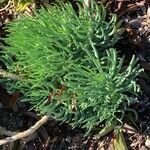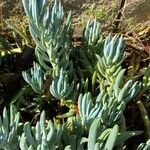Caudices to 2 dm × 1.5-3.5 cm, clumps to 5 dm diam. Leaves without resinous odor; rosette 15-25-leaved, 5-10 cm diam.; blade light green, linear, terete and widened above clasping base, 8-20(-40) × 0.3-0.9 cm, 4-9 mm thick, to 2 times wider than thick, base 15-30 mm wide, surfaces not farinose, not viscid, not oily. Inflorescences: cyme 2-15-branched, flat-topped to mostly cylindric, 0.4-1 × 0.4-1 dm; branches 1-2 times bifurcate; cincinni 3-12-flowered, subcircinate, 4-11 cm, floral shoots 2-7 dm × 3-10 mm; leaves 15-35, strongly ascending, triangular-lanceolate, (terete or somewhat flattened in basal 1/2), 2-5 × 0.3-1 cm. Pedicels 1-2(-5) mm. Flowers: petals spreading or slightly reflexed from near middle, connate 1-2 mm, white, elliptic-oblong, 7-10 × 2-3 mm, apex acute, corolla 15-20 mm diam.; pistils erect, 6-8 mm; styles 1.5-2 mm. Follicles ascending, with adaxial margins ca. 30-45º above horizontal. 2n = 34.
More
A bushy succulent. It grows 40 cm high and spreads 40 cm wide. The leaves are in rings often arranged in spirals. They are fleshy and like fingers. They often have a floury coating of wax. The flower stalks have arrow shaped bracts. The flowers are bell shaped. They are white.
It is a Mediterranean climate plant. They need warmth and light. It is best in a rich, well-drained soil. It needs an open, sunny position. It is resistant to drought but damaged by frost.
More
Rocky hillsides below 1,000 metres. High elevations in the Sonoran Desert.



